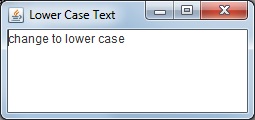Change the Case of Text in a Java Program
By Stephen Bucaro
In computer programming, a letter or digit is called a character and a collection of letters
or digits that make a phrase, sentence, or paragraph, is called a string.
If you compare two characters or two strings, Java will say they are different if all the characters
are not the same case. The binary character code for uppercase A is 0100 0001, while the code
for lower case a is 0110 0001. To make a comparison without consideration for case, you can first
convert all the characters in a string to lower case using the String objects toLowerCase
method, or the String objects toUpperCase method. Code for this is shown below.
import javax.swing.*;
public class lowercaseText
{
public static void main(String s[])
{
JFrame frame = new JFrame();
frame.setDefaultCloseOperation(WindowConstants.EXIT_ON_CLOSE);
frame.setSize(300,300);
frame.setLocationRelativeTo(null);
frame.setTitle("Lower Case Text");
String testText = "CHANGE TO LOWER CASE";
String result = testText.toLowerCase();
JTextArea myText = new JTextArea();
myText.setLineWrap(true);
myText.append(result);
frame.add(myText);
frame.setVisible(true);
}
}

I generally hate it when people add a bunch of extra code to an example. It confuses things.
But in this case I've included the javax.swing library and added code to create a
JFrame and a JTextArea. If I didn't add this extra code, you would need to use
the System.out.print command to output text, and I don't think that's an interesting
or realistic way to learn Java programming.
In the code shown above, the line String testText = "CHANGE TO LOWER CASE" declares a
String object and initializes it with the string "CHANGE TO LOWER CASE", the next line uses
that objects toLowerCase method to change any upper case characters in the string to
lower case (in this case, all the characters). A String object named result is declared
and the lower case strint returned is stored there.
A JTextArea object named myTextis created, and the line myText.append(result)
places the lowercase string in the JTextArea for display in the program window.
Note that, although in Java, the names of primitive variable types, like int and char
begin with lower-case letters, the String variable type is capitalized. That's because strings
are actually objects, which makes them very powerful because they contain methods like
.length() and getChars.
If you're a beginner, for this example, I recommend downloading and installing the Java Development Kit from
Oracle's web site.
Type the code into a text file using a basic text editor like Window's Notepad (Do not use a word processor
because they insert formatting codes into the file), saving the file with the .java file extension. Then
use a batch file to compile the program. The batch file needs to contain the path to the compiler and the
path to the source file, an example of compile.bat is shown below.
c:\Program Files\java\jdk1.8.0_121\bin\javac c:\Users\Stephen\Desktop\program_name.java
pause
The pause command on the second line will cause the DOS shell to stay open until you press any key,
allowing you to read any errors. If successful, the compiler will create an executable file with the
.class file extension. Then use a batch file to run the program. The batch file needs to contain
the start command, the name of the java program launcher, and the name of the compiled java class
file (without the .class extension). An example of run.bat is shown below.
start javaw program_name
The javaw launcher displays the result of your program, or error information if it fails, in a window.
Note: Another way to make a character or string comparison without consideration for case is to
use the equalsIgnorecase method.
| 
